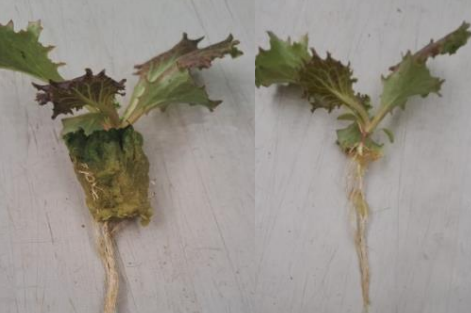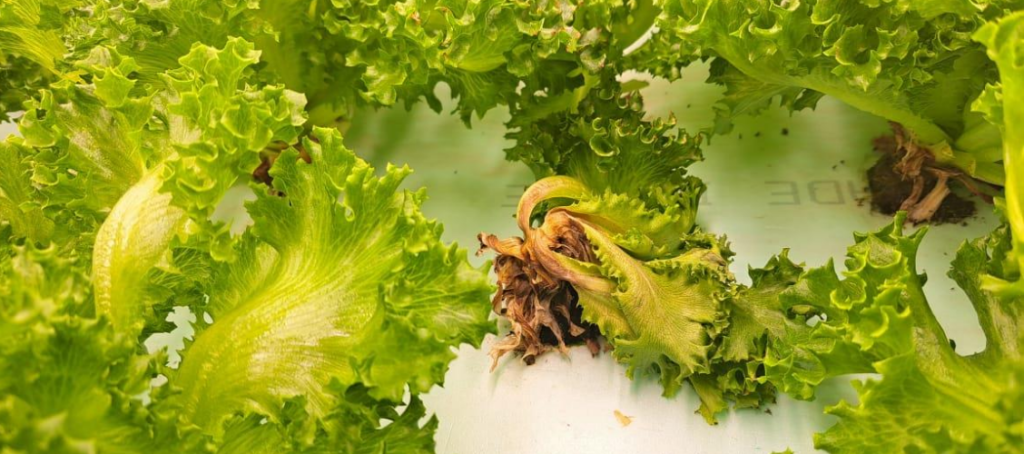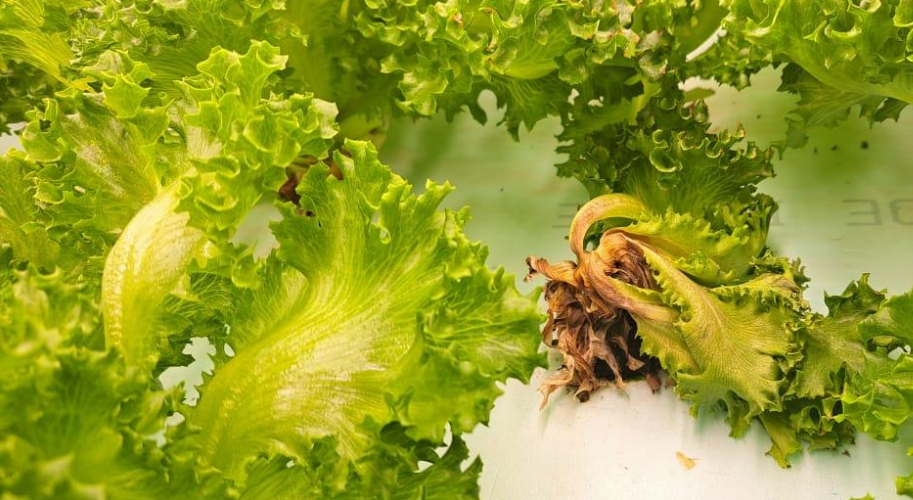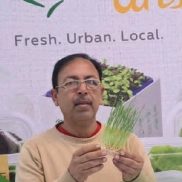Integrated management of Pythium in Hydroponic Lettuce
*Co-author: Yasmin Barkat, Horticulturist & Hydroponic Farming (Trainer), Mymaximus, Dubai, UAE
The constantly increasing earth’s population creates an urgent and challenging need to cover the higher demand for food. Every country is taking the initiative regarding food security for their people. With the help of modern techniques and technology, crop yield can be increased; among the technologies used is the “Controlled Environment Agriculture (CAE).” With this emerging technology, per unit area production is higher than in conventional agriculture. Although all the factors associated with crop production are generally under control, the environment still needs a lot of investigation, and research aspects like economic viability, infrastructure design, and production optimization are being evaluated.
Crops grown in conventional (open Field ) and high-tech (CAE) are threatened by pests and diseases. There are many kinds of diseases which may be fungal or bacterial. Some are manageable and can be prevented easily, but some severely affect the plant, even damaging the whole plant or crop in a very short time. In this article, I will share my experience and strategy to control Pythium Disease, which can cause severe loss of hydroponically or greenhouse lettuce crops.
The most commonly reported agents for Pythium root, also known as water mold, are:
1) pythium aphanidermtum and
2) pythium dissotocum
Fig 1 shows that the plant’s root system is not well developed, and the pythium attack on the roots, root tip, and feeder roots caused decreased development of the organs, compared to the root system of a healthy plant Fig-2 & 3.

Fig. 1 Plant infected with Pythium

Fig-2 & 3 Healthy, fully developed lettuce roots
Pythium can affect the plant at the pre-emergence and post-emergence growth stages. In the case of pre-emergence, damping-off causes seeds and young seedlings to rot before they emerge from the growing medium; at the nursery stage, you can lose a maximum number of seedlings if pythium outbreaks. Fig-4 shows the uneven germination of seeds and the unsuccessful emergence of seeds from the rook wool / growing media.

Fig. 4. How pythium is affecting sprouting and emergence of lettuce seedlings
In the case of Post emergence, damping off kills the newly emerged seedling. In ‘post-emergence’ damping-off, the pathogen causes a water-soaked, soft brown lesion at the stem base that pinches off the stem, causing the seedling to topple over and die. 
Fig. 5. Pythium-infected lettuce seedlings after transplanting
Fig. 5 shows the seedlings or young plants affected by pythium attack after transplanting; the transplanting date of all plants in this is the same, but you can observe the growth pattern is uneven, the lower leaves are turning yellow, the plants with severe infestation showing the stunting growth and ultimately die.
In young plants, Pythium causes crown and root rot; while scouting your crop, you will observe the wilting phenomena of the plants. In the root system, initial symptoms appear as brown to dark-brown lesions on root tips and feeder roots, and as the disease progresses, signs of soft, brown stubby roots lacking feeder roots become visible (Figure 1). In larger roots, the outer root tissue or cortex peels away, leaving the string-like vascular bundles underneath. Pythium rot also occurs in the crown tissue at the stem base (Figure 6). 
Fig. 6: Pythium crown rot at the stem base; the plant suddenly wilts, topples, and dies.
Management Strategy of Pythium in lettuce plants growing in a protected environment
The key to keeping your plants healthy is Monitoring, Monitoring, Monitoring.
I repeat the monitoring word three times, meaning the daily and proper monitoring through an outcropping cycle is a preventive strategy that is better than curative. Removal and disposal of infected plants should be done.
In hydroponic or greenhouse production systems, the primary source of pythium infection is water; the irrigation water should be treated and filtered before being applied to the plants. Municipality water is considered safe from pythium. Water storage tanks must be clean and disinfectant on periodically basis.
Inexpensive methods for removing Pythium from water: Heat, ultraviolet light, ozone, and chlorination can be effective but are expensive and require some training to be used properly. Regular cleaning and disinfection of the growing area/greenhouse-like surfaces, equipment, pipelines, walkways, and old plant debris. Water temperature should be maintained between 20-22°C, which is an effective way to control infections but not eliminate them. Frequent reservoir changes for recirculating hydroponic systems are a simple yet effective way of ensuring the build-up of zoospores does not happen. A low level of oxygen is also one of the causes to increase pythium infection, ensuring adequate aeration greater than 6 ppm (deal saturated level of oxygen of about 8 – 9 ppm in nutrient hydroponic solution. High fertility promotes the disease, especially Nitrate fertilizer, keeping the nutrient solution Ec 1.1 -1.3
The application of fungicide effectively controls the pythium in a hydroponic system. In my experience and practical trial, applying products containing the active ingredient (Azoxistrobin +Mefenoxam), or copper (Syngenta), have a very good result and can successfully control the pathogen. Hydrogen peroxide is also effective in reducing infestation; the other benefit of hydrogen peroxide is to increase the dissolved oxygen level in the nutrient solution.
References for further information
- Agriculture: Floriculture and Ornamental Nurseries Pest Management Guidelines University of California Agriculture and Natural Resources
https://ipm.ucanr.edu/agriculture/floriculture-and-ornamental-nurseries/pythium-root-rot/ - Pythium Diseases of Greenhouse Vegetables, March 2021 Ministry of Agriculture, Food & Fisheries, British Columbia
https://www2.gov.bc.ca/assets/gov/farming-natural-resources-and-industry/agriculture-andseafood/animal-and-crops/plant-health/phu-pythiumdiseases-greenhousevegetablecropsss.pdf - Penn State Extension. 2017. Pythium, online factsheet. Retrieved on January 23, 2018 from https://extension.psu.edu/pythium
Further reading
Integrated management of Pythium in Hydroponic Lettuce
The challenge of producing red lettuce variety on an indoor farm










































































